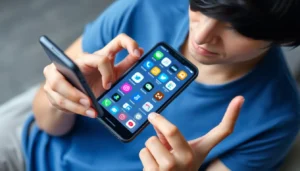Backing up an iPhone to a Chromebook might sound like trying to teach a cat to swim. But fear not! With a few simple steps, you can save your precious photos, contacts, and that one embarrassing meme you can’t seem to delete. It’s easier than finding a Wi-Fi signal in a coffee shop.
Table of Contents
ToggleOverview of Backing Up iPhone
Backing up an iPhone is essential for preserving important data. Data loss can happen unexpectedly, making regular backups crucial.
Importance of Regular Backups
Regular backups provide security for valuable information. Data such as photos, contacts, and important documents remains safe with consistent backups. Users may face data loss due to accidental deletion, software malfunctions, or device damage. Staying ahead of these risks with frequent backups ensures that critical files remain accessible. Reliability is key when relying on backups to restore lost data quickly.
Common Backup Methods
Multiple methods exist for backing up an iPhone, each with unique advantages. iCloud allows users to automatically back up data wirelessly, making it convenient. Alternatively, using iTunes or Finder offers a way to back up via a computer, providing local storage for files. Third-party apps also serve as options, providing additional features like encryption and selective backup. Each method has its own appeal based on user preferences and needs.
Preparing Your Chromebook for Backup

Preparing a Chromebook for backing up an iPhone involves a few essential steps. Users must ensure their device meets specific system requirements to facilitate a smooth backup process.
System Requirements
A compatible Chromebook is necessary for this task. Chromebooks need a minimum of 64 GB of storage for adequate space during backups. Additionally, they should be updated to the latest Chrome OS version for optimal performance. Users also benefit from having a stable internet connection, especially if they plan to use cloud services for backup. An Apple ID is required to access iCloud services, while USB ports are essential for direct connections with an iPhone.
Installing Necessary Applications
Installing necessary applications on a Chromebook enhances the backup experience. Users should download the Google Drive app to efficiently manage files. Access to third-party backup applications like SyncDrive can also prove useful for transferring data. Moreover, ensuring that Chrome Remote Desktop is installed simplifies remote access to an iPhone. Familiarity with these applications streamlines the process, making it easier to back up important data from the iPhone to the Chromebook.
Steps to Backup iPhone to Chromebook
Backing up an iPhone to a Chromebook involves straightforward methods. Users can choose between Google Drive and file transfer methods.
Using Google Drive
Google Drive provides a seamless way to back up important data. First, install the Google Drive app on the iPhone. Next, open the app and log in with the Google account. Select the files or folders for backup, such as photos and documents. After choosing, tap the upload button to start the backup process. Access the backed-up files later on the Chromebook by logging into Google Drive. This method allows quick access and organization of files across devices.
Using File Transfer Methods
Transferring files directly from an iPhone to a Chromebook is another effective strategy. Connect the iPhone to the Chromebook using a USB cable. Enable file transfer mode on the iPhone for access. Open the Files app on the Chromebook to view the iPhone files. Drag and drop selected items, such as videos and contacts, into the Chromebook’s storage. After completion, safely eject the iPhone. This approach ensures a quick and efficient transfer of essential data.
Troubleshooting Common Issues
Backing up an iPhone to a Chromebook might present some challenges. Addressing these common issues can streamline the process and minimize frustration.
Connection Problems
Connection issues often hinder the backup process. First, ensure the USB cable is secure and functioning. Loose connections frequently disrupt data transfer. If using Google Drive, a stable Wi-Fi connection is essential. Weak signals can lead to interrupted uploads. Restarting both devices can also resolve transient connectivity problems. Consider switching USB ports if they do not work properly. Frequently, drivers need updating to maintain a stable connection, especially on the Chromebook side. Troubleshooting the network settings may also prove beneficial if persistent connection problems arise.
Backup Incomplete Errors
Incomplete backups can arise for several reasons. Insufficient storage on the Chromebook might prevent a full transfer of data. Users should verify that enough space exists before retrying the backup process. Sometimes, specific files may not meet backup criteria due to file type restrictions. Review individual settings within apps like Google Drive to adjust what gets backed up. It’s crucial to ensure the iPhone’s iOS is current, as outdated software often causes incompatibilities. Furthermore, issues may stem from Google Drive’s limitations, such as file size or connection errors. Regular monitoring can help prevent incomplete backups by flagging potential issues early.
Backing up an iPhone to a Chromebook may seem daunting but it’s a manageable task with the right approach. By utilizing tools like Google Drive or direct file transfer methods users can ensure their important data is securely stored. Regular backups not only protect against unexpected data loss but also provide peace of mind.
Familiarity with the necessary applications and troubleshooting tips enhances the overall experience making the process smoother. Taking the time to set up the Chromebook correctly and following the outlined steps will lead to successful backups. With these strategies in place users can confidently safeguard their valuable information.







